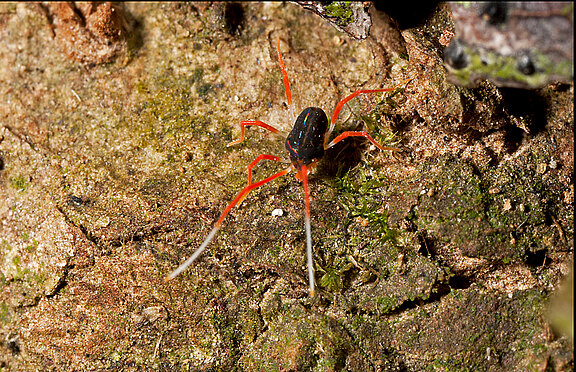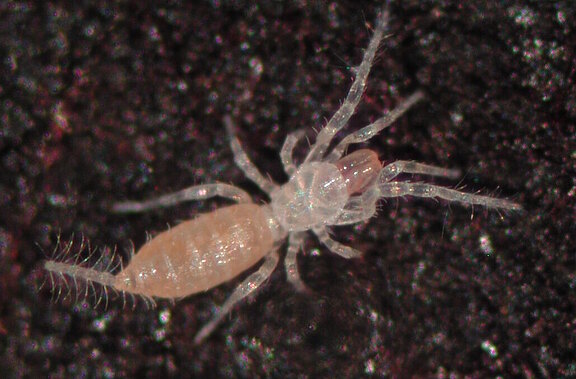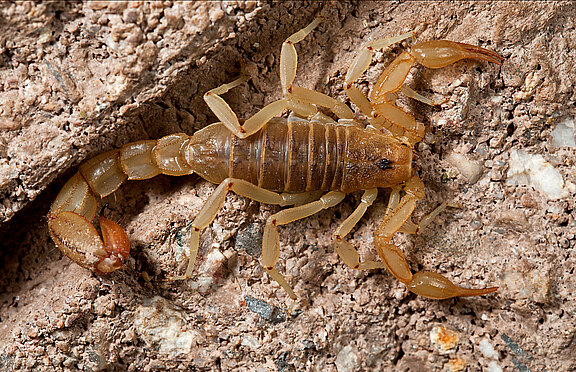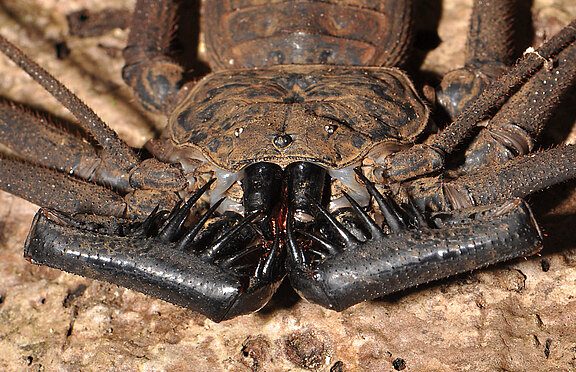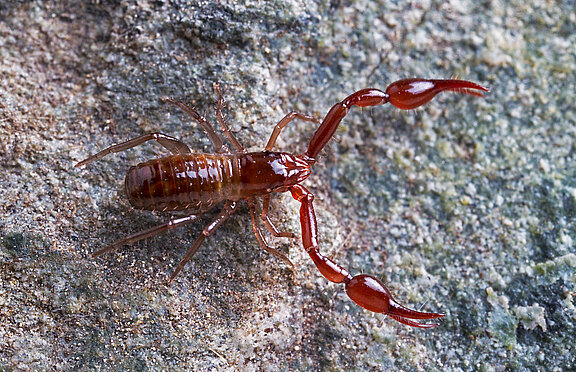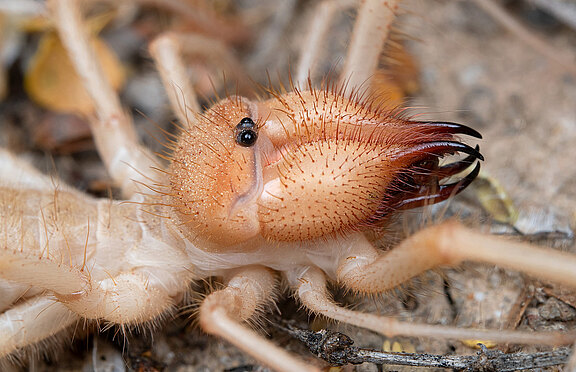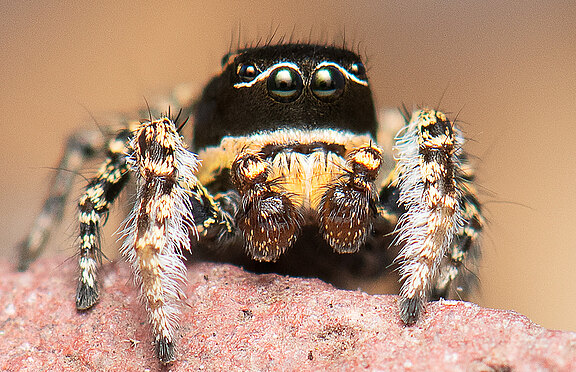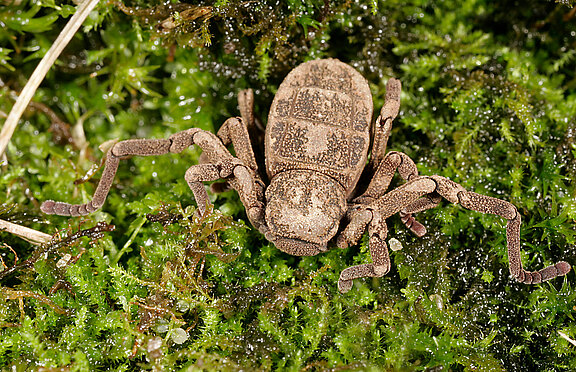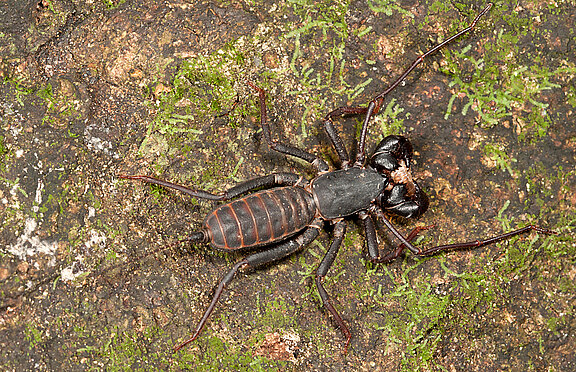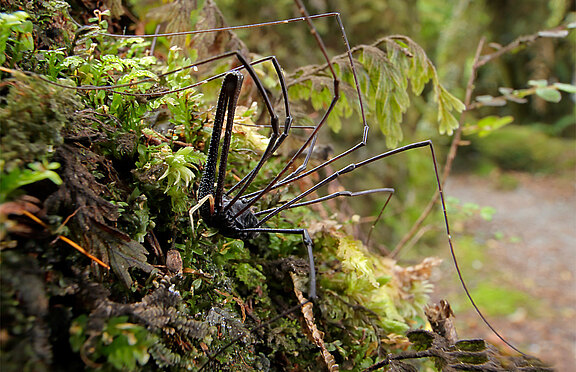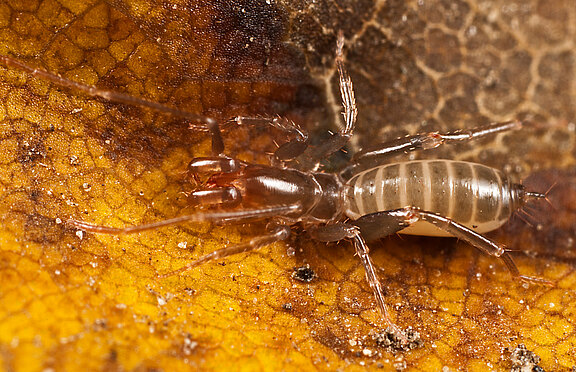List of all articles
Volume 49 Number 2
geographic parthenogenesis, sex ratio, sexual reproduction
Abstract
Most Brazilian yellow scorpion (Tityus serrulatus Lutz & Mello, 1922) populations reproduce by parthenogenesis, and only a few sexually reproducing populations are known. It has been suggested that the parthenogenesis in T. serrulatus is related to bacterial endosymbionts, but this hypothesis was recently refuted, so the causes of parthenogenesis in this species are still unknown. In the present study, we report parthenogenetic reproduction in females from a sexual population, either isolated in laboratory since birth or collected at juvenile stages. Twelve females collected as juveniles became adult and reproduced without contact with males (thus, through parthenogenesis) in the laboratory. Five females collected already pregnant gave birth to litters (F1) composed only of females, which is suggestive of parthenogenesis in the field. Eight F1 females from those litters subsequently reproduced by parthenogenesis in the laboratory. Another female collected already pregnant gave birth to a litter composed of males and females (F1), indicating sexual reproduction in the field. However, one F1 female from that litter reproduced by parthenogenesis in the laboratory. These results suggest that asexual reproduction is facultative in this population.
Volume 49 Number 2
Arachnid, arthropod, immunology, innate immunity
Abstract
Treatment of bacterial cultures with hemolymph collected from desert hairy scorpions (Hadrurus arizonensis Ewing, 1928, Hadruridae) resulted in a time- and concentration-dependent inhibition of bacterial proliferation. The hemolymph proved effective in inhibiting growth of both Gram-negative and Gram-positive bacterial species. Incubation of E. coli bacteria with hemolymph at different temperatures (20–408C) showed that the antibacterial effects increased from 20–308C, but the hemolymph was largely ineffective in killing the bacteria at 35 and 408C. Incubation of E. coli with hemolymph at 258C for different time periods revealed that the antibacterial activities were extremely rapid and resulted in killing of bacteria within 1–2 minutes of contact. Interestingly, the hemolymph exhibited no phenoloxidase enzyme activity, hemolytic activity against sheep red blood cells, or melanization activity, which is a common mechanism of immunity among many diverse arthropods. This study is the first characterization of immune function of hemolymph from any scorpion species.
Volume 49 Number 2
Mating dance, courtship, ram’s horn organs, spermatophore
Abstract
The arachnid order Pseudoscorpiones is characterized by a huge number of different mating strategies. Cheliferidae, for instance, have developed complex mating dances, including the use of the curious ram’s horn organs of males. The present study provides a detailed description of the mating behavior of Dactylochelifer latreillii latreillii (Leach, 1817), including first quantitative data for each behavioral unit, based on the analysis of laboratory video captures of individual mating ceremonies. Previous studies on mating in cheliferids have been purely qualitative, including a description of mating in a distinct subspecies of D. latreillii, D. l. septentrionalis Beier, 1932. Qualitatively, our data on Dactylochelifer l. latreillii is roughly consistent with these older observations except for some differences in the vibrating behavior of males.
Volume 49 Number 2
Intrasexual polymorphism, alternative reproductive tactic, population genetics, species delimitation, Pettalidae
Abstract
Neopurcellia salmoni Forster, 1948 is a mite harvestman found throughout the forests of the west coast of New Zealand’s South Island. This species range is unusually large for the notoriously dispersal-limited Cyphophthalmi, raising the possibility of multiple cryptic species within the lineage. In order to test this hypothesis, we used scanning electron microscopy to examine a large number of individuals from throughout its range, and discovered two distinct male morphotypes distinguished by the presence or absence of dorsal glandular pores. We performed phylogeographic and population genetic analyses using DNA sequence data from the fast-evolving mitochondrial locus cytochrome c oxidase I (COI). Tree topologies revealed two well-supported clades within Neopurcellia Forster, 1948 occupying non-overlapping geographical regions of the west coast. Molecular dating indicates that these lineages diverged from each other following the Oligocene ‘‘drowning’’ of New Zealand and diversified during the uplift of the Southern Alps. The strong correlation between the evolutionary relationships of lineages within Neopurcellia and the geographic distribution of its populations indicates isolation by distance, as expected with dispersal-limited organisms; population genetic analyses confirm strong isolation of populations. However, we discovered that the distribution of male morphotypes does not follow any geographic or phylogenetic pattern. While the presence of two different morphotypes initially suggested multiple Neopurcellia species, phylogeographic analysis allowed us to reject this hypothesis. We therefore report here the first known case of male polymorphism in the suborder Cyphophthalmi.
Volume 49 Number 2
Zoological nomenclature; Arachnida; Caelopyginae; Goniosomatinae
Abstract
The English counterpart of Cuvier’s Le Re`gne Animal, organized by Edward Griffith in several volumes, contained not only a translation of the French original, but also new material added by invited collaborators. The part on Arachnida, with new material contributed by George R. Gray, contained descriptions of five species of Opiliones, one of them a mite, and two of them new. There are identifications, synonymies and homonymies involved in the taxonomy of these species which are questioned herein. Gonoleptes spinipes Gray, [20 July] 1833 is a senior primary homonym of Gonyleptes spinipes Perty, [13 December] 1833. This is currently a species inquirenda in Caelopyginae, which is newly considered a subjective synonym of Metarthrodes triangularis Roewer, 1931. The latter name should stand in virtue of the senior being invalid by homonymy. Gonoleptes spinipes Gray is also a new subjective synonym of Goniosoma roridum Perty, 1833, which is in prevailing usage, which makes it a nomen protectum.
Volume 49 Number 2
Taxonomy, chaetotaxy, edaphic fauna.
Abstract
A new species, Eukoenenia sinensis, is described and illustrated from specimens collected in two forests in nearby islands in Guangdong Province, Southeast China. The genus Eukoenenia is recorded for the first time from China and it represents the second palpigrade species reported for this country after Koeneniodes madecassus Re ́my, 1950. The new species shares several morphological characters with other soil-dwelling Eukoenenia species from Africa, Asia and South America. One of the distinctive characters of E. sinensis is the presence of 6 pairs of setae (a1, a2, a3, a4 þ s1, s2) on opisthosomal sternites IV to VI, a character only shared with another five species. Eukoenenia sinensis is most similar to specimens captured from Chile and identified by Dr. Bruno Conde ́ as Eukoenenia cf. grassii; several morphological and morphometric features allow to differentiate both species. From the other four species, two can be readily distinguished by their troglomorphic characters, and the other two are soil-dwelling species that show differences in the chaetotaxy of basitarsus IV, metapeltidium, deutotritosternum, opisthosomal tergites III–VI, as well as the number of teeth in the cheliceral fingers. In addition, E. sinensis is the first palpigrade to exhibit sexual dimorphism in the number of thick setae of coxa IV.
Volume 49 Number 2
Transition metals, chelicerate, enrichment, whip spiders, SEM-EDS
Abstract
Amblypygi is a small order of arachnids that includes the whip spiders. Like other members of the clade Pedipalpi, these arachnids are cryptic predators that use their antenniform appendages to detect prey, and spinose pedipalps for quick prey capture. To date, there is very little information on the composition of their exoskeleton despite its importance in predation and defense. Here, we performed the first analysis of a whip spider exoskeleton using energy- dispersive X-ray spectroscopy (SEM-EDS). Our studies of Phrynus marginemaculatus CL Koch, 1840 were designed to (1) determine if elemental profiles differ between instars and (2) determine if and how elemental profiles of whip spiders differ from other closely related arachnids. We found the whip spider exoskeleton to contain several trace metal elements including calcium, magnesium, manganese, potassium, sodium, and zinc. The diversity and abundance of trace elements is relatively low throughout the exoskeleton of 2nd instars but increases in adults. In particular, the chelicerae and pedipalps are well reinforced with several metal elements, most notably calcium and zinc, which are also present in the tarsal claws. A similar elemental distribution is known for adult whip scorpions (Thelyphonida). In P. marginemaculatus, these metal elements are similarly present in adult exuviae. The elemental enrichment of the whip spider exoskeleton is comparable to that present in other members of the Pedipalpi and Tetrapulmonata, reflecting a relatively conserved profile for the few species that have been examined.
Volume 49 Number 2
behavioral manipulation, molting hormone, Ichneumonidae
Abstract
In previous studies, the ‘‘cocoon’’ webs built by spiders of the genera Cyclosa Menge, 1866 and Allocyclosa Levi, 1999 under the influence of Polysphincta spp. wasps resembled molting webs built by unparasitized spiders; this behavioral manipulation was associated with increased concentrations of the molting hormone ecdysone. The present study documents an additional aspect of the cocoon webs of Allocyclosa bifurca (McCook, 1887) built under the influence of the wasp Polysphincta gutfreundi Gauld, 1991. Molting webs were more likely to have an associated barrier web than were prey capture orbs; and cocoon webs were even more likely to have barrier webs. The similarity between molting and cocoon webs accords with previous indications of ecdysone use by the wasps. The accentuation of molting web traits in the cocoon webs (also seen in other species) implies that the wasps manipulate the spiders using mechanisms other than simply replicating hormonal stimuli involved in normal molting.
Volume 49 Number 2
Alternative food resource, Castanea crenata, phenology, plant-eating, Quercus serrata
Abstract
Accumulated studies have revealed that spiders, which are believed to be true predators, also feed on various plant materials such as pollen, nectar, and stigmatic exudate. Hereby, we report observational cases of fermented tree sap feeding by four spider species, namely Sinopoda forcipata (Karsch, 1881) (Sparassidae), Otacilia komurai (Yaginuma, 1952) (Phrurolithidae), Weintrauboa contortipes (Karsch, 1881) (Pimoidae), and Doenitzius cf. peniculus Oi, 1960 (Linyphiidae), in deciduous forests in Japan. This is the first report of spiders feeding on fermented sap, and also the first report of plant material consumption in the families Sparassidae, Phrurolithidae, and Pimoidae.
Volume 49 Number 2
Courtship, copulation, male silk-laying, spiderlings
Abstract
In spiders, intersex communication during courtship is essential to avoid the risks of cannibalism due to lack of specific recognition. Parabatinga brevipes (Keyserling, 1891) is a Ctenidae spider with a distribution from Colombia to Uruguay. This study is the first to describe the sexual behavior of P. brevipes, and the fourth reported in the family. We introduced males to females in a cage and recorded their courtship and copulation behavior. Males began courtship after touching female silk, performing Leg-tapping of legs I and Palpal movements. We observed ten copulations that usually occur vertically, in the copulatory position reported for other ctenids, with the male on top of the female, oriented in opposite directions. Copulations usually involve the insertion of one male palp in a single female’s genital opening and finish with the pair dropping from the vertical position. These sexual behaviors are compared with reports of other species in the family.
Volume 49 Number 2
Salticidae, chemical ecology, sexual selection, mate searching
Abstract
Jumping spiders are known for complex courtship displays with both visual and vibratory components, but increasing evidence shows they also use chemoreception in intraspecific communication. We conducted two experiments using Habronattus pyrrithrix (Chamberlin, 1924) to assess male response to substrate-borne or airborne chemical cues produced by virgin females. First, we tested the effect of substrate-borne cues by allowing males to inspect two pieces of filter paper that had either been exposed to a female (thus covered in silk and/or excreta) or not (control). Second, we used a Y-tube olfactometer to test male response to female airborne cues versus a no-odor control in the absence of substrate- borne cues. Males responded to substrate-borne cues (spending more time traversing and palpating female-treated filter paper compared with the control) but did not respond to airborne cues alone. Together, these experiments suggest male H. pyrrithrix may use contact chemical cues from female silk to locate or assess females.
Volume 49 Number 2
Araneophagy, diet breadth, prey acceptance, specialization, termitophagy
Abstract
Spiders are among the most taxonomically diversified orders of predators, but data on the trophic niche of most species are still unknown. Here, we investigated the fundamental trophic niche of two species of jumping spiders, Cyrba algerina (Lucas, 1846) and Heliophanus termitophagus Wesołowska & Haddad, 2002, for which data on their realized trophic niche suggest trophic specialization (feeding on other spiders or termites, respectively). We investigated their fundamental trophic niche by means of acceptance experiments. Both species accepted a broader spectrum of prey under laboratory conditions than in the field, suggesting they are euryphagous specialists.
Volume 49 Number 2
Arachnida, aflagellate spermatozoa, Laniatores, reproduction.
Abstract
Arachnida evolved different reproductive strategies in the terrestrial habitats. Knowledge of the morphology of reproductive systems varies depending on the group, and for Opiliones only a few studies exists addressing this topic. Here, we describe the morphology of the male reproductive tract and the spermatozoon of the harvestman Mischonyx cuspidatus (Roewer, 1913). In this species, males have a single testis, a pair of deferent ducts, a seminal vesicle, a propelling organ and a penis. The lumen of the folded seminal vesicle and testis follicles are filled with spermatozoa, suggesting a storage of sperm related to a possible reproductive strategy involving multiple matings. The spermatozoa are aflagellate and ca. 6.5 lm in length. This study sheds light on the knowledge of the harvestman’s reproductive biology and life strategy, which can be used in future studies involving Opiliones behavior and systematics.
Volume 49 Number 1
Araneae, Serpentes, black widow, Latrodectus, Theraphosidae, predation, intraguild predation, venomous spiders, venomous snakes
Abstract
In this paper, 319 incidents of snake predation by spiders are reported based on a comprehensive global literature and social media survey. Snake-catching spiders have been documented from all continents except Antarctica. Snake predation by spiders has been most frequently documented in USA (51% of all incidents) and Australia (29%). The captured snakes are predominantly small-sized with an average body length of 25.9 6 1.3 cm (median 1⁄4 27 cm; range: 5.8–100 cm). Altogether .90 snake species from seven families have been documented to be captured by .40 spider species from 11 families. About 60% of the reported incidents were attributable to theridiids (’0.6–1.1 cm body length), a spider family that uses strong tangle webs for prey capture. Especially the Australian redback spider (Latrodectus hasselti Thorell, 1870), the African button spider (Latrodectus indistinctus O. Pickard-Cambridge, 1904), an Israeli widow spider (Latrodectus revivensis Shulov, 1948), and four species of North American widow spiders (Latrodectus geometricus C.L. Koch, 1841, Latrodectus hesperus Chamberlin & Ivie, 1935, Latrodectus mactans (Fabricius, 1775), and Latrodectus variolus Walckenaer, 1837) – equipped with a very potent vertebrate-specific toxin (a- latrotoxin) – have proven to be expert snake catchers. The use of vertebrates as a supplementary food source by spiders represents an opportunity to enlarge their food base, resulting in enhanced survival capability. Interestingly, the snakes captured by spiders also encompasses some species from the families Elapidae and Viperidae known to be highly toxic to humans and other vertebrates. Not only do spiders sometimes capture and kill snakes, quite often the tables are turned – that is, a larger number of arthropod-eating snake species (in particular nonvenomous species in the family Colubridae) include spiders in their diets.
Volume 49 Number 1
New species, spider evolution, subfamily Arbanitinae, taxonomy
Abstract
The arbanitine spiny trapdoor spiders of the genus Cryptoforis Wilson, Rix & Raven, 2020 are revised, and 15 new species are described from eastern Australia: C. absona sp. nov., C. arenaria sp. nov., C. cairncross sp. nov., C. cassisi sp. nov., C. celata sp. nov., C. cooloola sp. nov, C. fallax sp. nov., C. grayi sp. nov., C. hickmani sp. nov., C. mainae sp. nov., C. montana sp. nov., C. monteithi sp. nov., C. woondum sp. nov., C. xenophila sp. nov., and C. zophera sp. nov. The type species, C. hughesae Wilson, Rix & Raven, 2020, and two other previously described species, C. tasmanica (Hickman, 1928) and C. victoriensis (Main, 1995), are re-described and re-diagnosed, and a key to all species in the genus is provided. Species of Cryptoforis are characterized by ‘wafer-door’ burrow entrances; the cryptic nature of these burrows in the natural environment likely contributed to the relatively recent recognition of their widespread occurrence in mainland eastern Australia. One species, however, is an exception: C. fallax sp. nov. constructs a ‘palisade’ type burrow remarkably similar to those created by the turrificus-group in the sister-genus Euoplos Rainbow, 1914. The subtropical region around the McPherson–Macleay overlap appears to be the center of diversity for Cryptoforis; however, given the cryptic nature of burrows, and the confinement of some known species to cool, high elevation habitats (which can be difficult to access and sample), we suggest that additional species likely remain undiscovered in parts of New South Wales and tropical northern Queensland.
http://zoobank.org/References/00C25CBC-265D-4F17-892F-BEC2955C6922
Volume 49 Number 1
Mesozoic, paleobiogeography, Palpimanoidea, systematics
Abstract
The Crato Formation (Lower Cretaceous) of Brazil is well known for an exceptionally preserved terrestrial arthropod fossil assemblage. Spiders are relatively abundant, but few have been formally described. A fossil spider belonging to the family Palpimanidae, araneophageous ground-dwelling spiders with distinctly robust front legs, is preserved with the dorsal side hidden within the rock matrix. For the first time, micro-computed tomography (micro-CT) was used to image a fossil spider preserved in a rock matrix, to reveal the dorsal side of this specimen, revealing the eye arrangement, a useful taxonomic character in most spiders, and a deflated abdomen, likely the result of taphonomic processes. The specimen possesses other distinguishing characteristics of Palpimanidae, including an inflated first leg femur, a heavily sclerotized scutum, and a reduced number of spinnerets (2) surrounded by a sclerotized ring. The spider has eight eyes with the lateral pairs extremely close together, a trait suggestive of the subfamily Chediminae. The specimen also possesses an unusual first leg patella with a retrolateral excavation and a thorn-like projection. A new genus is erected, and the spider is named Cretapalpus vittari gen. et sp. nov. A phylogenetic analysis including extant species from each of the subfamilies within Palpimanidae places the fossil at the base of Chediminae þ Otiothopinae. This is the earliest reported fossil palpimanid and first chedimine from South America. A fossil chedimine in South America is not surprising because the South American and African plates were still relatively close during the Early Cretaceous.
Volume 49 Number 1
Coercive sexual behavior, female choice, Megacormus gertschi, scorpion venom
Abstract
The males of the Mexican species Megacormus gertschi D ́ıaz-Najera, 1966 (Scorpiones: Euscorpiidae: Megacorminae) sting the female repeatedly in the pedipalp tibia-patella intersegmental membrane (TPIM) during the initiation of the promenade a deux. It has been suggested that the male’s venom introduced during this ‘‘sexual sting’’ behavior could generate some sedative effect and reduce the possibility of being cannibalized by the female. However, this is unsupported by evidence regarding venom transference. Here, we provide evidence of perforation of the TPIM by the male aculeus and venom transfer during sexual sting performance. We also provide the first venom characterization of this species and show that it has a sexually dimorphic composition. These results, in combination with observations that the sexual sting is displayed in successful matings with non-defensive females, lead us to consider the pre-insemination sexual stinging as a non-genitalic sexual interaction with a potential role as a courtship element.
Volume 49 Number 1
Chelonethi, male genital armature, homology.
Abstract
Propositions of homology are fundamental in systematics, since they provide the basis for supporting clades. Consequently, such phylogenetic propositions rely on correct character and character state definitions. Although male genital morphology is a key source of information for understanding the phylogeny and classification of the Withiidae (Pseudoscorpiones), they have only been subjected to examination in six of the 170 species of the family. The suprageneric classification of the Withiidae is unstable, as subfamilies and tribes are not well supported by morphological characters, and only the unranked group of genera Cacodemoniini is currently accepted. The aim of the present work is to characterize the male genital armature of the Cacodemoniini and propose homology statements for these structures based upon their morphological correspondence. Through direct examination and literature review of 12 of the 13 genera of the Cacodemoniini, we provide the first structural correspondence statements and descriptions of variation for the dorsal apodemes, the ejaculatory canal, the lateral apodemes, and the lateral rods; we also conclude that unlike other pseudoscorpions, the Cacodemoniini have paired, independent lateral rods and a long ejaculatory canal formed not by the dorsal apodemes exclusively, but by a fusion of the dorsal and the lateral apodemes. The proposed interpretations lay the groundwork for phylogenetic testing of homologies and may allow a better understanding of the formation of the spermatophore, given that it is molded by the genital armature.
Volume 49 Number 1
Prey, natural enemies, predation, cannibalism, autotomy
Abstract
The Neopilionidae is a highly diversified harvestman family in New Zealand, comprising eight genera and 28 species. Although individuals of many species are abundant in the field, basic information on their natural history is absent. Here we describe the diet, predators, and defensive behaviors of 13 species across three genera, Forsteropsalis Taylor, 2013, Mangatangi Taylor, 2013, and Pantopsalis Simon, 1879. Using three years of field observations, we first identify food items for this family, finding that New Zealand neopilionids are opportunistic, generalist foragers with a diet composed of a wide variety of prey and scavenged soft-bodied invertebrates, including worms, amphipods, species from nine orders of insects, and two orders of arachnids (including conspecifics). We then describe the first known invertebrate predators of New Zealand harvestmen, including seven spider species, and conduct a review of the literature to collate a list of 32 species of native and non-native vertebrates (frogs, lizards, fish, birds, and mammals) that prey on harvestmen, including neopilionids. Finally, we describe the defensive behaviors of neopilionids, providing the first reports of autotomy and thanatosis in the family. In general, the diet of New Zealand neopilionids is similar to other harvestman species, and the list of predators includes mostly insectivorous taxa known to feed on harvestmen elsewhere. The defensive repertoire of neopilionids includes behaviors recorded for other species of Eupnoi, such as leg autotomy, but also unique behaviors that are only known for species of Dyspnoi and Laniatores, such as thanatosis.
Volume 49 Number 1
Cribellate silk, hunger, collective behavior
Abstract
Spider webs are characteristic of a species, yet web architecture, the amount of silk laid, and silk mechanics are plastic at an individual level. These different web parameters are influenced by the spiders’ own intrinsic state as well as biotic and abiotic conditions. When compared to satiated spiders, hungry spiders are known to build bigger webs, alter the mesh width of the web or increase the frequency of web-building. Although the influence of hunger on web architecture is known in solitary spiders, it has not been studied in social spiders. Here, we examine how prey availability affects the amount of web and cribellate silk laid in the social spider Stegodyphus sarasinorum, Karsch, 1892 (Eresidae). In a laboratory setup, we observed that unfed spiders invest more in web-building, compared to fed spiders. Unfed social spider colonies laid more silk, particularly cribellate silk, than fed colonies. Our results help to shed light on the plasticity of web architecture in social spiders with respect to changes in prey availability.
Volume 49 Number 1
Cocoon web, Polysphincta genus group, koinobiont ectoparasitoid, Neotropical.
Abstract
In this study, we report a new interaction of the wasp Zatypota riverai Gauld, 1991 (Ichneumonidae) parasitizing the spider Cyclosa fililineata Hingston, 1932 (Araneidae) and we describe the modified spider web. Our results show that parasitized spiders build modified webs that are clearly different from normal capture webs. This modified web presents several additional lines at the center of the web, forming a disk-like structure that was also observed in modified webs of other host orb-weaving spiders. To our knowledge, Z. riverai (this study) and Z. kauros Gauld, 1984 are the only two species of the genus Zatypota that use spiders from different families as host. However, the unexpected host C. fililineata could be an accidental host, since in the same region there are two of the typical hosts, the theridiid spiders Anelosimus baeza Agnarsson, 2006 and Theridion sp.
Volume 49 Number 1
Male egg-guarding, mate guarding, reproduction, Honduras, Cusuco
Abstract
We report observations over several field seasons of egg and juvenile guarding by males of a Central American species of cosmetid harvestman (Opiliones: Cosmetidae), Cynorta bromeliacia Goodnight & Goodnight, 1947. This represents only the second species of the family Cosmetidae that has been reported to exhibit paternal care. Importantly, we observed multiple instances of solitary male egg-guarding, including examples where eggs and young were at different stages of development. We also observed a few cases of mate guarding by a male at an oviposition site, where the female was near to eggs that appeared to have been recently laid. We discuss these observations in relation to the arboreal tendency of this species and speculate that oviposition sites are close to roosting sites or other such refuges for either the male or both sexes. Given the weak sexual dimorphism displayed by the species, we discuss that the externally visible characters we used to identify males are unlikely to provide any advantage in fighting off conspecific males. We also suspect that females may produce multiple clutches in this species, but this remains to be verified. Finally, we discuss how our findings at the end of the wet season may relate to the local microclimate and suggest further standardized observations throughout the year are required.

